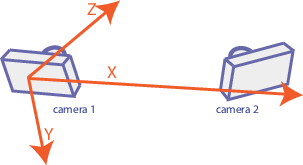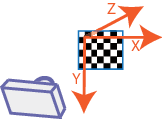triangulate
3-D locations of undistorted matching points in stereo images
Syntax
Description
worldPoints = triangulate(matchedPoints1,matchedPoints2,stereoParams)
worldPoints = triangulate(matchedPoints1,matchedPoints2,camProjection1,camProjection2)
[
additionally returns reprojection errors for the world points using any of the input
arguments from previous syntaxes.worldPoints,reprojectionErrors]
= triangulate(___)
[
additionally returns the indices of valid and invalid world points. Valid points
are located in front of the cameras.worldPoints,reprojectionErrors,validIndex]
= triangulate(___)
Examples
Input Arguments
Output Arguments
Tips
The triangulate function does not account
for lens distortion. You can undistort the images using the undistortImage function before detecting
the points. Alternatively, you can undistort the points themselves
using the undistortPoints function.
References
[1] Hartley, Richard, and Andrew Zisserman. Multiple View Geometry in Computer Vision. 2nd ed., 312-313. Cambridge, UK ; New York: Cambridge University Press, 2003.
Extended Capabilities
Version History
Introduced in R2014bSee Also
Apps
Functions
triangulateMultiview|reconstructScene|estimateCameraParameters|cameraProjection|undistortImage|undistortPoints|estrelpose




